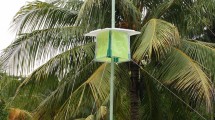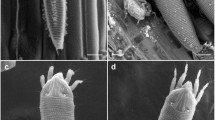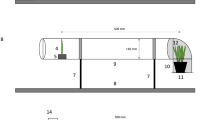Abstract
Dispersal can be a crucial factor affecting fitness in insects. We conducted a series of experiments and observations with the aim of determining the dispersal mode of the African root and tuber scale Stictococcus vayssierei, a pest on cassava in the Congo Basin. We monitored the main options of dispersal that occurred in scale insects: wandering of first-instar nymphs (crawlers), active dispersal by ant workers, phoresis on colony-founding queen ants, and passive dispersal by wind. Results showed that A. tenella workers are actively involved in the transport and dissemination of scale crawlers. When ants were excluded, crawlers could move by themselves for a short distance to find the host plant. In the presence of ants, crawlers were transported by ant workers for longer distance across the bridge and established on scale-free plants. Scales transport increased with the duration of the experiment and ant density. Neither a case of phoresis nor dispersal by wind was recorded, suggesting that passive dispersal is rare. These results outline the active role of A. tenella workers in the dispersal of immature stages of S. vayssierei in Southern Cameroon and have implication in the management of the scale on cassava.



Similar content being viewed by others
References
Beardsley JW, Gonzalez RH (1975) Biology and ecology of armored scales. Annu Rev Entomol 20:47–73
Buschinger A, Heinze J, Jessen K, Dowes P, Winter U (1987) First European record of a queen ant carrying a mealybug during her mating flight. Naturwissenschaften 74:139–140
Das GM (1959) Observations on the association of ants with coccids of tea. Bull Entomol Res 50:437–448
Fotso Kuate A, Tindo M, Hanna R, Kenne M, Goergen G (2008) Foraging activity and diet of the ant, Anoplolepis tenella Santschi (Hymenoptera: Formicidae), in southern Cameroon. Afr Entomol 16:107–114
Gaume L, Matile-Ferrero D, McKey D (2000) Colony foundation and acquisition of coccoid trophobionts by Aphomomyrmex afer (Formicinae): co-dispersal of queens and phoretic mealybugs in an ant-plant-homopteran mutualism? Insectes Soc 47:84–91
Greathead DJ (1972) Dispersal of the sugar-cane scale Aulacaspis tegalensis (Zhnt) (Hem, Diaspididae) by air currents. Bull Entomol Res 61:547–558
Greathead DJ (1990) Crawler behaviour and dispersal. In: Rosen D (ed) Armored scale insects: their biology, natural enemies and control. Elsevier Scientific Publishers, Amsterdam, pp 305–308
Greathead DJ (1997) Crawler behaviour and dispersal. In: Ben-Dov, Y and Hodgson, C J (ed) Soft scale insects - their biology, natural enemies and control, Elsevier Science BV, pp 339–342
Gullan PJ (1997) Relationship with ants. In: Ben-Dov Y and Hodgson CJ (ed) Soft scale insects - their biology, natural enemies and control. Elsevier Science BV, pp 351–373
Gullan PJ, Kosztarab M (1997) Adaptation in scale insects. Annu Rev Entomol 42:23–50
Handa C, Ueda S, Tanaka H, Takao Itino T, Itioka T (2012) How do scale insects settle into the nests of plant-ants on Macaranga Myrmecophytes? Dispersal by wind and selection by plant-ants sociobiology 59:1–12
Hanna R, Tindo M, Wijnans L, Goergen G, Tata Hangy K, Lema K, Toko M, Ngeve JM, Dixon A, Gockowski J (2004) The African root and tuber scale problem in Central Africa: the nature of the problem and the search for control options. In: Book of Abstracts of the 9th Triennial Symposium of the International Society for Tropical Root Crops - Africa Branch, 31 October–5 November 2004, Mombasa, Kenya, pp 57
Jahn GC, And Beardsley JW (1996) Effects of Pheidole megacephala (Hymenoptera: Formicidae) on survival and dispersal of Dysmicoccus neobrevipes (Homoptera: Pseudococcidae). J Econ Entomol 89:1124–1129
Johnson C, Agosti D, Delabie JHC, Dumpert K, William DJ, Tschirnhaus MV, Maschwitz U (2001) Acropyga and Azteca Ants (Hymenoptera: Formicidae) with scale insects (Sternorrhyncha: Coccoidea): 20 million years of intimate symbiosis. Am Mus Novit 3335:1–21
Kishimoto-Yamada K, Itioka T, Kawai S (2005) Biological characterization of the obligate symbiosis between Acropyga sauteri Forel (Hymenoptera: Formicidae) and Eumyrmococcus smithii Silvestri (Hemiptera: Pseudococcidae: Rhizoecinae) on OkinawaIsland, southern Japan. J Nat Hist 39(40):3501–3524
Klein RW, Kovac D, Schellerich, Maschwitz U (1992) Mealybug-carrying by swarming queens of a Southeast Asian bamboo-inhabiting ant. Naturwissenschaften 79:422–423
Malsch AKF, Kaufmann E, Heckroth H-P, Williams DJ, Maryati M, Maschwitz U (2001) Continuous transfer of subterranean mealybugs (Hemiptera, Pseudococcidae) by Pseudolasius spp (Hymenoptera, Formicidae) during colony fission? Insectes soc 48:333–341
Nondillo A, Sganzerla VMA, Bueno OC, Botton M (2013) Interaction between Linepithema micans (Hymenoptera: Formicidae) and Eurhizococcus brasiliensis (Hemiptera: Margarodidae) in Vineyards. Environ Entomol 42:460–466
SAS (2008) SAS software 92. SAS Institute Inc, Cary
Smith MR (1942) The relationship of ants and other organisms to certain scale insects on coffee in Puerto Rico. J Agr Univ Puert Rico 26:21–27
Washbum O, Washburn L (1984) Active aerial dispersal of minute wingless arthropods: exploitation of boundary-layer velocity gradients. Science 223:1088–1089
Washburn JO, Frankie GW (1981) Dispersal of a scale insect, Pulvinariella mesembryanthemi (Homoptera: Coccoidea) on iceplant in California. Environ Entomol 10:724–727
Way MJ (1954) Studies on the association of the ant Oecophylla longinoda (Latr) (Formicidae) with the scale insects Saissetia zanzibarensis Williams (Coccidae). Bull Entomol Res 45:113–134
Williams ML (1997) The immature stages. In: Ben-Dov Y and Hodgson CJ (ed) Soft scale insects - their biology, natural enemies and control. Elsevier Science BV, pp 31–48
Acknowledgments
This work was supported by special project funds provided to the International Institute of Tropical Agriculture by the Research Fellow Partnership Program (RFPP) and the International Fund for Agricultural Development (IFAD).
Author information
Authors and Affiliations
Corresponding author
Rights and permissions
About this article
Cite this article
Fotso, A.K., Hanna, R., Tindo, M. et al. Transport and Dispersal of Stictococcus Vayssierei (Hemiptera, Stictococcidae) by Anoplolepis Tenella (Hymenoptera, Formicidae). J Insect Behav 28, 426–435 (2015). https://doi.org/10.1007/s10905-015-9513-5
Revised:
Accepted:
Published:
Issue Date:
DOI: https://doi.org/10.1007/s10905-015-9513-5




